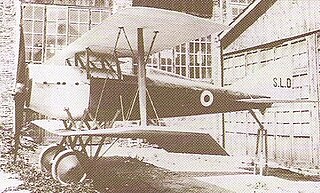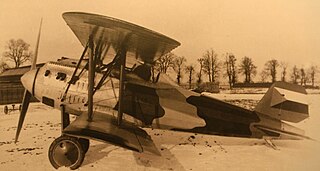
The Dewoitine D.1 was a French single-seat fighter aircraft of the 1920s, built by the French industrial company Dewoitine.

The SIAI S.52 was an Italian fighter prototype of 1924.

The Piaggio P.2 was an Italian fighter prototype of advanced design built by Piaggio in 1923.
The Gabardini G.8 was an Italian single-seat aircraft produced in both fighter and trainer versions by Gabardini in 1923.

The Ducrot SLD was an Italian fighter prototype built by Ducrot in 1918.

The Marchetti MVT, later renamed SIAI S.50, was an Italian fighter of 1919 and the early 1920s.

The SIAI S.58 or Savoia-Marchetti S.M.58 was an Italian flying boat fighter prototype of the 1920s designed and manufactured by SIAI.

The Macchi M.26 was an Italian flying boat fighter prototype of 1924 designed and manufactured by Macchi.

The Nieuport-Delage NiD 120 series was a series of French single-seat parasol monoplane fighter aircraft of the 1930s. It was built in a number of versions, fitted with various types of engines, with six aircraft designated NiD 123 being sold to Peru.

The Nieuport-Delage NiD 48 was a French single-engine parasol wing light fighter aircraft, designed and built in the 1920s. Its performance was not markedly better than that of the much heavier Nieuport-Delage NiD 62 then going into production, so only two were flown.

The Wibault 8 or Wib 8 Simoun (Simoon) was a tandem seat, parasol wing fighter aircraft designed and built in France to a 1925 specification which was later withdrawn; only one Wib 8 was completed.
The Wibault 9 or Wib 9 was a single seat, parasol wing fighter aircraft designed and built in France in the 1920s. It was a re-engined version of the relatively successful Wib 7, but failed to reach production.

The Letov Š-7 was a single-seat, single-engine biplane fighter aircraft designed and built in Czechoslovakia in the early 1920s. It was designed for a single-seat fighter competition but did not reach production.
The Letov Š-13 was a single-seat, single-engine fighter aircraft designed and built in Czechoslovakia in the early 1920s. A biplane, it had aerodynamically thick wings which were originally cantilever structures, though interplane struts were later added. Only one was produced.

The Letov Š-14 was a single-seat, single-engine aircraft, designed and built in Czechoslovakia in the early 1920s. Originally intended as a biplane fighter, it was later modified into a monoplane and entered as a contestant in a speed competition.
The Letov Š-22 was a single-seat, single-engine aircraft designed and built in Czechoslovakia in the mid-1920s. A parasol-wing Dewoitine-style fighter, it was not successful, and only one was built.
The Dewoitine D.15 was a single-engine, single-seat biplane fighter aircraft built in France in the 1920s. Intended to offer structural simplifications when compared with monoplanes, it had a disappointing performance and was soon abandoned.
The Hanriot HD.5 was a French two-seat fighter aircraft prototype, built towards the end of World War I. A single-engine biplane with an unusually narrow gap between the upper and lower wings, it did not enter production.
The Hanriot HD.20 was a French single seat shipboard fighter aircraft prototype completed in 1923. Only one was built.

The FVM J 23 was a Swedish single seat, single engine, parasol wing fighter aircraft built in the mid-1920s. Five were flown but the type never reached operational status because of structural concerns raised by a fatal accident.















